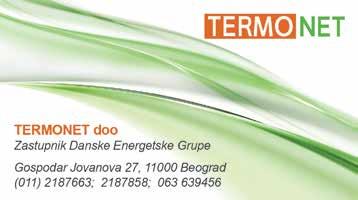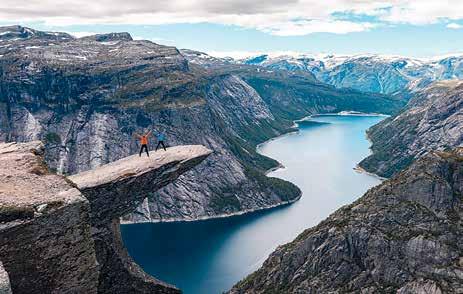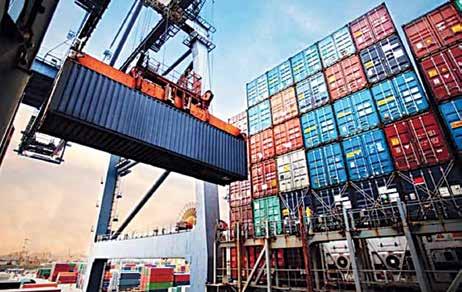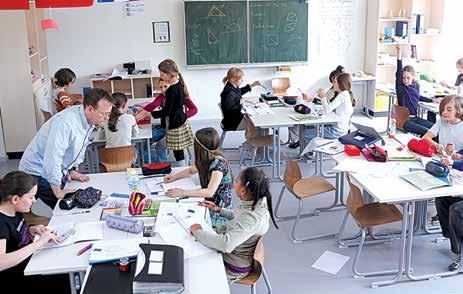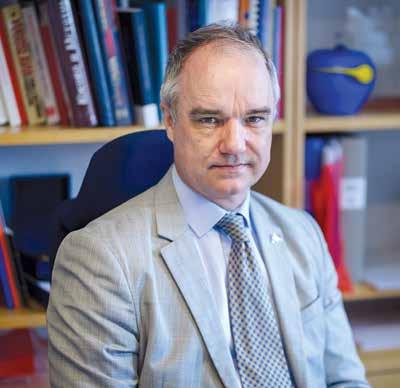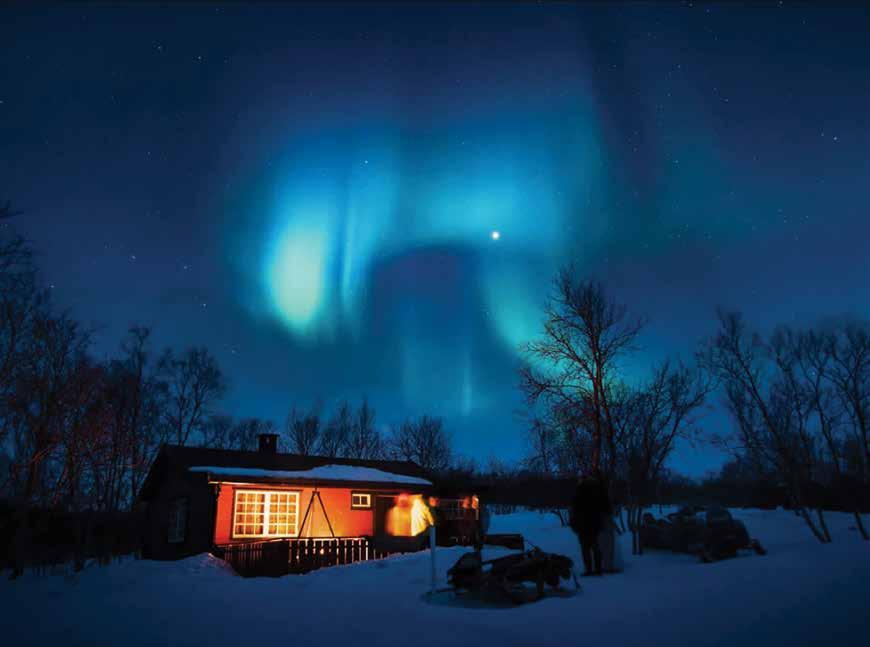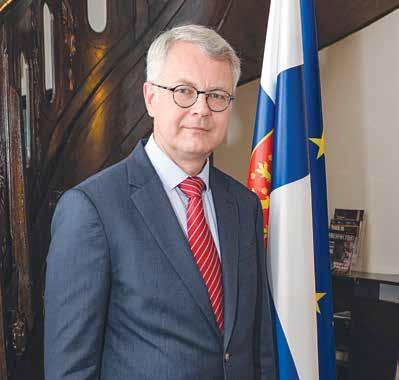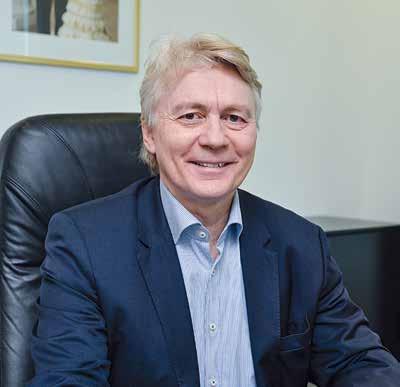
13 minute read
DIALOGUE IS CRUCIAL IN HARD TIMES
We believe that good policies come as a result of permanent dialogue and trust between the public and private sectors. That is especially so now – when the global pandemic is changing the way we work and live. Our cooperation, trust and dialogue are essential
Nowadays, when the world is witnessing a viral outbreak that’s unprecedented in the modern history of the world, the Nordic Business Alliance is contributing actively to the continuing efforts of the Government and ad-hoc bodies aimed at helping Serbian society cope with the consequences of the Covid-19 crisis. Although it is obvious that the association’s initial plans developed for 2020 will go through some changes in scheduling, the major topics that the Alliance is working on won’t be changed, says Nordic Business Alliance President Ksenija Purković. Nordic countries and companies cooperate very well and often act together. How are these principles applied when it comes to the Nordic engagement in Serbia? - Members of the Nordic Business Alliance in Serbia gather around the core Nordic principles, such as transparency, cooperation, innovation and corporate social responsibility, regardless of their country of origin. Our members are Nordic, but also other international and local companies gathered around those core values. In practical terms, we strive to maintain the good dialogue already established with the Government on topics such as the environment, digital technologies, innovation and tourism. We believe that good policies come as a result of permanent dialogue and trust between the public and private Members of the NBA in Serbia gather around core Nordic principles - transparency, cooperation, innovation and corporate social responsibility
Advertisement

Although the Covid-19 pandemic will impact on our work in 2020, our mission and strategic goals will remain the same, and they are related to environmental protection, ICT and healthcare
Photo: Anđela Grozdanić
sectors. Especially now - when the global pandemic is changing the way we work and live - our cooperation, trust and dialogue are essential. Luckily, we can work and communicate digitally, which will hopefully minimise the impact of the pandemic outbreak.
If we take the example of the Nordic Days event, how do you decide which topics are important to be pursued? Which of them are in your focus in 2020? - Our goals for 2020 are a result of deep internal consultations among members. Taking into account the interests and structure of our members, we have decided to launch several working groups. Those groups will promote good practices in the areas and interests of our members. The Nordic Business Alliance in Serbia has established several working groups in this regard: the Task Force for Environmental Protection, Waste and Renewable Energy; the Task Force for ICT – Information and Communication Technologies; the Task Force for Healthcare and Public Health. Of course, we are fully aware that the Covid-19 pandemic will impact on our work in 2020 and that we will most likely have to recalibrate our activities for this year. Nevertheless, our mission and strategic goals will remain the same.
Considering that Nordic countries are among the most advanced, both in terms of innovation and, for example, in education, how do you relay acquired knowledge and knowhow with your Serbian counterparts? One example of the use of digitalisation and innovation for good is related to healthcare in Nordic countries. Which of those solutions can be applied in Serbia? - New technologies and innovation are things for which Nordic countries are famous. Innovation is spread over practically all parts of society – business, public services, transport, tourism, environmental protection and, of course, healthcare. We had several opportunities during 2019 to communicate good practices and the benefits of innovation to institutions - sometimes via more private platforms organised by the embassies of Nordic countries in Serbia, but also via conferences like the one entitled Innovation and Digitalisation in the Serbian Healthcare Sector, which was held at the National Assembly of the Republic of Serbia in November last year. This conference was supported by the Ministry of Health of the Republic of Serbia, and we had a fruitful debate on the integration of both digital technologies and innovation into the Serbian healthcare sector. I also have to note that last year was
Last year was relatively good for innovative pharmaceutical companies in Serbia, and we also salute the efforts of the state to embrace more innovative medications in the upcoming period
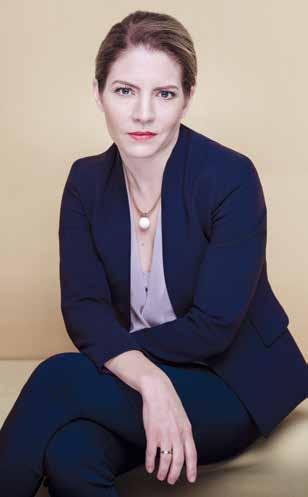
relatively good for innovative pharmaceutical companies in Serbia, as more innovative medications found a route to patients thanks to the decision of the National Health Insurance Fund of Serbia, and we also salute the efforts of the state to embrace more innovative medications in the upcoming period.
How does this impact on the work of pharmaceutical companies when it comes to bringing new solutions to the Serbian market? How would you assess the level of cooperation with the Serbian government vis-à-vis these initiatives? - As previously pointed out, we see more progress in cooperation and dialogue in general. Within the NBA we have three innovative pharmaceutical companies and have been maintaining a constant dialogue with institutions, both individually and collectively, throughout the year. We are aware that introducing innovative medications requires additional funds. Nevertheless, we believe that the wellbeing of patients and benefits to society outweigh the financial pressure in this case. The dialogue also ensures that we are listening to the needs of institutions and the community, and we are trying to respond adequately when possible. We are nowadays witnessing a viral outbreak that’s unprecedented in the modern history of the world, and we know that in such difficult times we need to be there for society. During these days we are consulting
Photo: Anđela Grozdanić
actively with the Government and ad-hoc bodies to help in coping with the medical consequences of the crisis.
As a female who chairs a major business alliance, how often do you see businesswomen occupying leading positions in Serbia? How do we fare compared with the level of equality in Nordic companies? - It is a pleasure to be at the helm of the NBA. I am also happy to tell you that, even in our board of governors, ladies usually represent the majority in meetings. Female empowerment is essential for the NBA, but even beyond that I believe that women still need to be more empowered to take on leading roles in society. Although there are successful women in the Serbian corporate world, we can do better. According to the EU Gender-Equality Index, Scandinavian countries top the list when it comes to gender equality in general. Serbia, on the other hand, is doing better than some EU member states, which means it isn’t that bad. According to some information I came across recently, females hold around 30 per cent of all managerial positions in Serbia. We can certainly do better than that!
Nordic culture and society have been having a bit of a moment internationally. Entire books have been written about the concept of hygge, and various Nordic words have been doing the rounds (lagom and kalsarikännit being rather different examples)
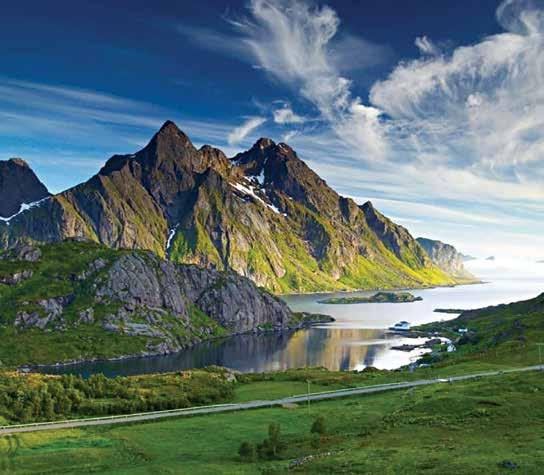
MYTHS
About Nordic Society
It seems that the Nordic countries are being noticed for more than just woolly socks and buzzwords, though. The “Nordic model” and Scandinavian society are being referenced by politicians and commentators more and more. In Europe, the Nordic countries are often brought up either as examples of successful welfare states – or as areas that breed depression and isolation simply by
NORDIC PEOPLE DO NOT LIVE IN THE COUNTRYSIDE
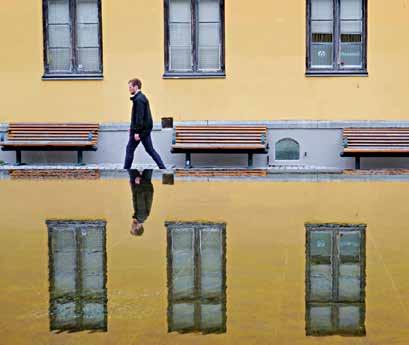

NORDIC PEOPLE ARE THE HAPPIEST IN THE WORLD
virtue of geography. As is often the case though, the truth is more nuanced than is often portrayed. Picture a Nordic home. Chances are you see a small red cottage with a pile of firewood outside – perhaps with a fjord or a forest in the distance and the calm of the countryside all around, adding to the cosy atmosphere. It is true that the populations of the Nordic countries are not very large relative to the size of the countries themselves. Iceland has a population density of 3.4 people per square kilometre. Denmark is fairly densely populated (134.76/km 2 – although the UK still has twice as many people per square kilometre – 270.7). Sweden, Finland and Norway are all relatively sparsely populated (23, 16 and 13.8 people per square kilometre, respectively). With stats like these, you might well think that everyone has a fjord or a forest for a back garden. However, the majority of people across the Nordic countries live in urban areas these days. In Iceland, the proportion of city dwellers is a rather high at 94% – the same as Puerto Rico – though you’re never that far from a hot spring or a volcano. The rest of the Nordic countries are not too far behind (88, 87, 85 and 82 per cent for Denmark, Sweden, Finland and Norway, respectively). So, while Nordic cities and towns are fairly small on a global scale (Stockholm’s metropolitan area is the largest in the Nordic region with 2.4 million inhabitants), the vast majority of Nordic people do not live in the countryside. But you’re never too far from a lake to jump into, a forest to wander in or a fell to climb. Listening to some of the comments popping up in the North-American dialogue about Nordic societies, you might be forgiven for thinking that they are all single-party dictatorships where you get assigned a job, a place to live and a haircut. At times, the European media seem to paint a picture of blissful socialist societies with flawless social security systems and schools that have done away with classrooms, tests and bullying altogether. The success of the workers’ movement and the social democratic parties did shape the Nordic region in the 20 th century. In Sweden, the local social democratic party The majority of people across the Nordic countries live in urban areas these days. In Iceland, the proportion of city dwellers is a rather high at 94%, though you’re never that far from a hot spring or a volcano. The rest of the Nordic countries are not too far behind (88, 87, 85 and 82 per cent for Denmark, Sweden, Finland and Norway, respectively)
PEOPLE IN FITNESS COURSE NORDIC WALKING IN NATURE
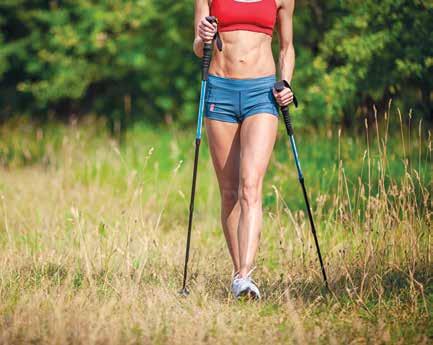
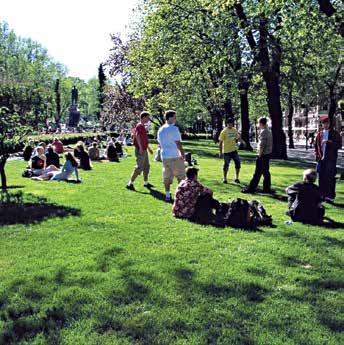
ESPLANADE PARK IN HELSINKI, FINLAND
was in power from 1932 to 1976, which allowed it to introduce significant social reforms, during a period which came to be known as Folkhemmet (“the people’s home”). Folkhemmet was not so much a social ist utopia as it was a compromise between capitalism and socialism, and reliant on the practice of consensus in politics and society at large. Looking at Nordic governments today, the social democratic parties are certainly still a driving force – even if their glory days seem behind them. Norway has a centre-right coalition government – Norway’s Prime Minister Erna Solberg is from the Conservative Party. Denmark’s social democrats have just won the largest share of the vote in the country’s latest election and are looking to form a broad coalition with ideas from both the left (a stronger welfare state) and the right (an even tougher im migration policy). Iceland’s coalition government includes parties from the left to the right and it is headed by Katrín Jakobsdóttir of the Left-Green Movement. At the moment, both Sweden and Finland have a PM from a social democratic party. Sweden’s government is a minority leftgreen coalition government and Finland’s has just announced a left-green-centre coalition government after tough negotiations. Like elsewhere in the world, the Nordic political map has been shaped by the rise of new right-wing populist parties, which often attract voters by focusing on immigration and nationalism. In Sweden, the Swedish Democrats, whose Eurosceptic, antiimmigration and socially conservative agenda got them 17.5% of the vote in the latest election in 2018, are in op position, largely because most major parties refused to negotiate with them. While all Nordic countries have a his tory that involves pivotal healthcare, social security and educational reforms pushed through by social democratic parties in the 20th century, the power of the social democrats is certainly not what it was in the past. A common stereotype about the Nordic countries is the idea that, as they are plunged into darkness half the year, depression is rife and suicide rates are extremely high. This is something that is hard to measure: misreporting and inaccurate statistics mean that global rates are not entirely reliable. It does seem that current suicide rates in the Nordic countries are relatively low on the global scale, although they do make it into the top 100 according to the WHO: Finland is in 32nd place and Iceland in 40 th place (Sweden, Norway and Denmark are in 51 st , 74 th and 89 th place, respectively). However, this is not the whole picture. Greenland is not included on this list as it is not an independent country, but an While all Nordic countries have a history that involves pivotal healthcare, social security and educational reforms pushed through by social democratic parties in the 20 th century, the power of the social democrats is certainly not what it was in the past
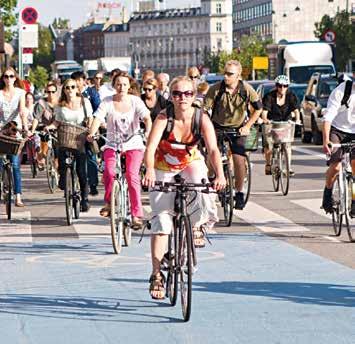
exactly central to the Nordic identity. According to the United Nations, happiness is about wellbeing: income (GDP per capita), social support, healthy life expectancy, freedom, generosity and the absence of corruption. It’s hard to argue with GDP or life expectancy figures. Apart from these facts, the survey also takes into account “national averages of positive and negative affect” – that is, people’s emotional experiences. Gallup conducted a survey of positive and negative emotions (e.g. experiencing respect, pain or worry or feeling well-rested or sad) in which the Nordic countries did not score anywhere near the top (the top three comprised Paraguay, Panama and Guatemala). It seems that people in the Nordic countries feel compara tively safe, if not enamoured with their existence. As long as “happy” does not mean “ecstatic” or “joyful”, Nordic people can be as content with the term as they (generally) are with their lives.
COPENHAGEN, CITY OF CYCLISTS
autonomous constituent country under Denmark. The suicide rate in Greenland began to rise in the 1970s and it is now the highest in the world. The rates in other Nordic territories have fallen considerably in recent decades – Finland’s was among the worst in the world only a few decades ago. It seems that societal changes might go further to explaining depression and suicide rates than climate – according to stud ies, the spring peak is a widely spread phenomenon on a global scale (and seems to be related to the change in temperature).

NORDIC PEOPLE ARE THE HAPPIEST IN THE WORLD The World Happiness Report was first published in 2012 and the Nordic countries have featured heavily in the top 10 every year since. In the 2019 report, Finland, Denmark, Norway and Iceland occupy the first four places, with Sweden in sev enth place. The reactions in the Nordic countries themselves have been somewhat mixed – of course people have it good, but “happy”, really? Being cheerful and happy-go-lucky isn’t
